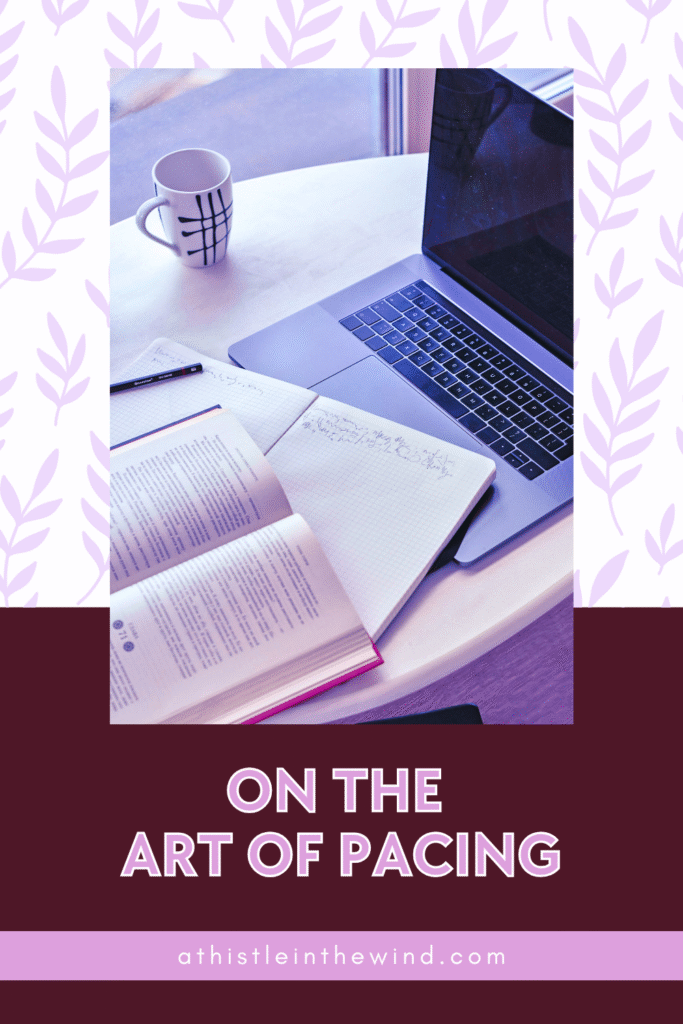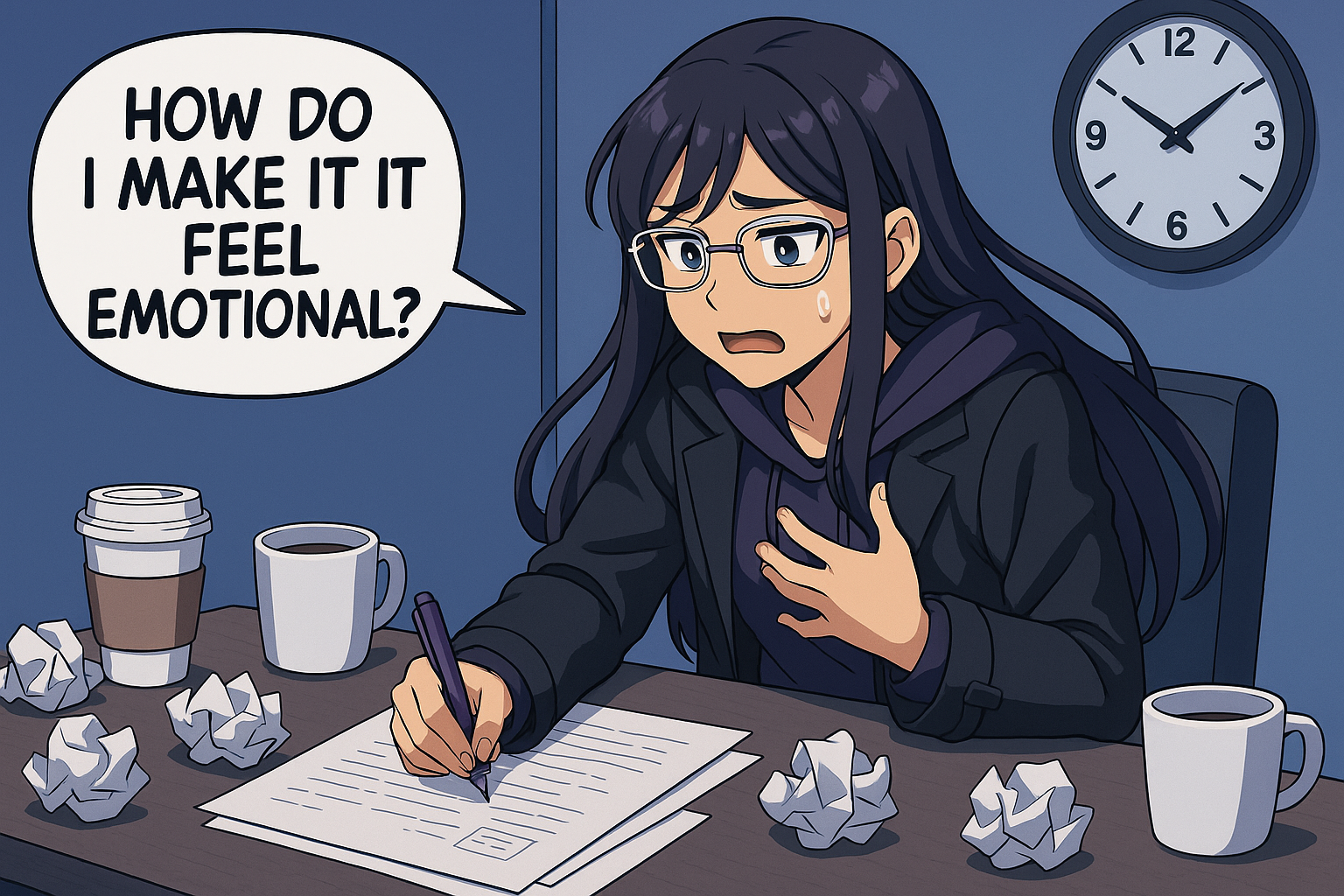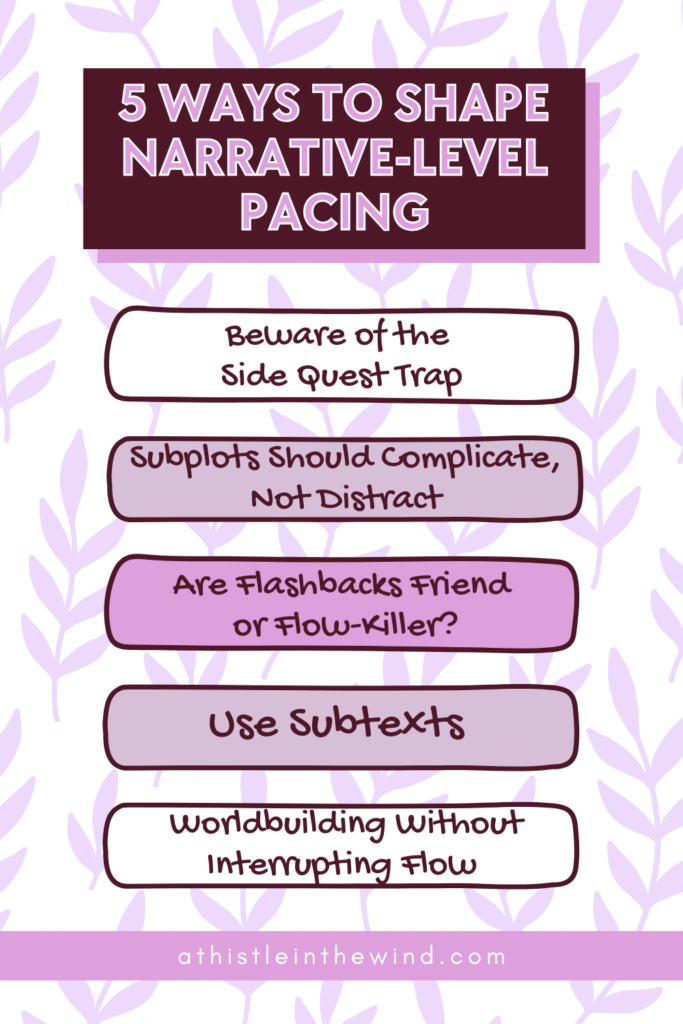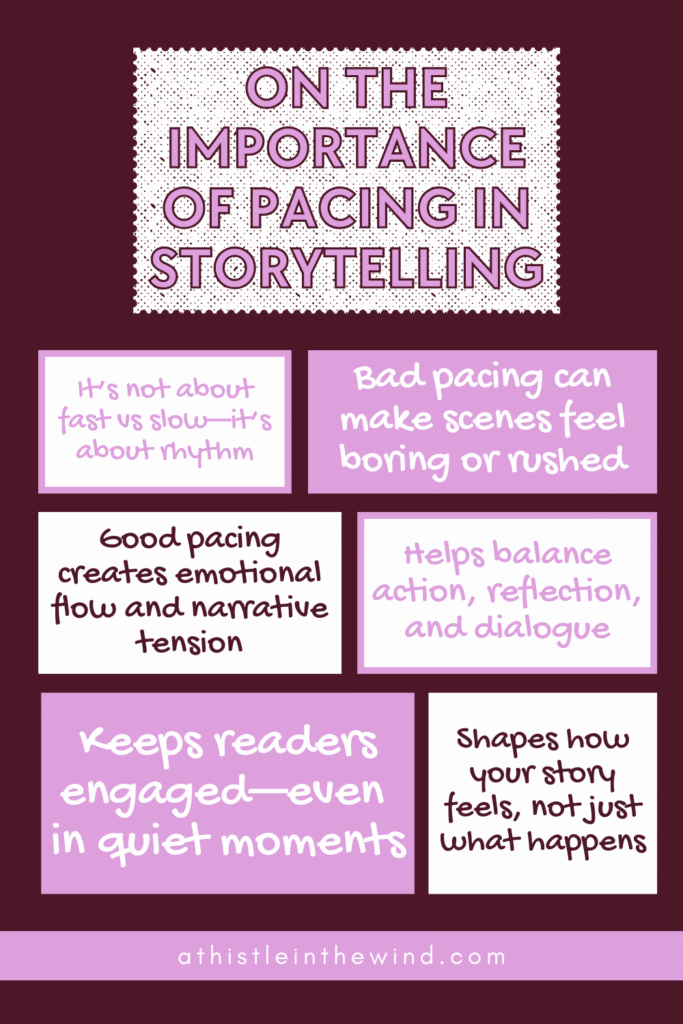On the Art of Pacing: A Writer’s Guide

A lot of writers struggle with pacing—and if you’re not sure what I mean, ask yourself this: have you ever written something that technically works, but just doesn’t feel right? Maybe your story drags in places, or events move so fast they don’t leave any emotional impact.
That’s pacing.
Or rather, that’s what happens when pacing goes wrong.
Pacing is the speed at which your reader experiences the events of your story. But don’t fall into the trap of thinking that fast is always good or that slow equals meaningful. Great pacing isn’t about speed—it’s about rhythm. It’s about knowing when to floor it and when to ease off the brake. It’s the beat that makes your story breathe.
In this blog, we’re taking a closer look at the art of pacing. So, let’s get started. But before, we begin:
Are you interested in the craft of writing? Check out these blogs:
- On Writing the First Chapter of a Novel
- On Writing Emotions: A Writer’s Guide to Mastering Feelings in Fiction
- How to Write the Perfect Scene: A Writer’s Guide
A Closer Look at Scene-Level Pacing

So, how do you actually control pacing at the scene level? It comes down to language choices—sentence structure, grammar, literary devices. These are your tools for shaping how fast or slow a moment feels.
1. Speeding Things Up: Sharp Sentences, High Stakes
When you want your readers to feel adrenaline, your sentences should reflect that intensity. Short. Snappy. Focused. Every word matters.
Here’s a perfect example from Robert Ludlum’s The Bourne Identity:
“He was slammed against the wall. Jason stood up and fired at the sound of his gun. The beam swung over to him; he was the target. Two shots came from the darkness…”
The clipped rhythm, the absence of flourishes, the immediacy—it compresses time. You feel like you’re right there, breath caught, flipping pages because you have to know what’s next.
And it’s not just about action. Even emotionally charged moments—panic, dread, desperation—can benefit from a fast pace. The trick is compression: drop the excess, focus on reactions and sensory details, and don’t let your reader look away.
2. Slowing Down: Deep Reflection and Emotional Space
On the flip side, slower pacing often appears in introspective or emotionally heavy scenes. Longer sentences, complex syntax, and repetition can slow the clock, mirroring a character’s inner world.
Let’s say your character is grappling with grief. You want the reader to linger—to sit with the weight of it. That doesn’t happen in one sentence. It happens over a paragraph, or maybe a page, where their thoughts loop, stall, rewind, and unravel.
This pacing invites the reader into the character’s interiority. Instead of action, the tension comes from emotion and subtext. It’s still compelling—just in a different key.

3. The Dance Between Tension and Time
High tension doesn’t always mean high speed. In fact, some of the most suspenseful scenes unfold slowly.
James Scott Bell, in Elements of Fiction Writing, highlights this brilliantly. Imagine a character waiting for a phone call that could change everything. Nothing is happening, and yet your reader is glued to the page. Why?
Because time is stretching. The internal tension is rising. The silence becomes oppressive. That’s pacing too.
4. Deliberate Delay: Lee Child and the Slow Build
In Worth Dying For, Jack Reacher calculates a single punch—but we don’t just get the punch. We get the thought process. The anticipation. The physics of impact. The reader is made to wait. And wait. And wait.
This kind of stretched pacing builds dread, curiosity, even anxiety. It’s not about movement—it’s about anticipation.
Remember: Emotional Tension Needs Space
When you’re writing emotional collapse or personal crisis, speed can actually undercut your impact. The scene might feel important, but if it happens too fast, the reader doesn’t have time to connect.
Stephen Chbosky gets this right in The Perks of Being a Wallflower. Charlie doesn’t just have a breakdown in a single paragraph. We watch it unfold. The repetition of “I’m fine” when he clearly isn’t. The growing gap between his internal reality and what he tells others. The slow, quiet unraveling.
Slowing down gives weight to emotional truth.
But like any tool, drawn-out tension can lose its edge if overused. A story that stretches every scene becomes sluggish—even if each moment is technically well written. Use slow pacing strategically, especially when emotional or psychological depth demands it.
Narrative-Level Pacing: The Big Picture

Let’s zoom out. What does pacing look like across an entire novel?
This is where things like chapter length, scene placement, subplot integration, and character arcs come into play. If scene-level pacing is about rhythm, narrative pacing is about flow—how everything moves together.
1. Beware of the Side Quest Trap
Ever read a book where the main plot suddenly pauses for a weird, disconnected errand?
That’s the side quest problem—when a story derails into tasks or scenes that don’t truly matter. If you can remove a subplot or obstacle and the ending still works the same, it’s probably a side quest.
These diversions might be entertaining in isolation, but they slow narrative momentum. And if they don’t develop the characters, deepen the conflict, or raise the stakes? Cut them. Or at the very least, rework them so they matter.
2. Subplots Should Complicate, Not Distract
A well-integrated subplot isn’t a detour. It’s a second thread that tangles with the first.
Think of Romeo and Juliet. The central plot is romance. But the Montague-Capulet feud? That’s a subplot that fundamentally shapes the ending. It adds conflict, emotional complexity, and narrative tension.
Ask yourself:
- Does this subplot change the stakes?
- Does it impact the main character’s choices?
- Would the story be incomplete without it?
If the answer is no, it might be a good moment to trim or combine.
3. Flashbacks: Friend or Flow-Killer?
Flashbacks deserve their own pacing conversation. They can absolutely enrich a story—if used well.
But if a flashback halts the main narrative, lacks urgency, or feels disconnected from what’s happening now, it risks flattening the momentum.
Flashbacks need to:
- Reveal crucial information
- Deepen character motivation
- Foreshadow or mirror future events
If they don’t do at least one of those things? It’s probably a backstory, not a flashback—and it might belong elsewhere.

4. Subtext: The Secret Engine of Pacing
Here’s a pacing tip most guides overlook: subtext speeds up the reader’s mind. When you write with subtext—those implied meanings, unsaid truths, and silent tensions—your reader becomes an active participant. They’re decoding. Reading between the lines. Staying engaged.
Even if the plot isn’t rushing forward, the mental engagement keeps things moving. In contrast, a text that spells out everything, no matter how eventful, can feel slow simply because there’s no intellectual friction.
Subtext invites curiosity. And curiosity is momentum.
5. Worldbuilding Without Interrupting Flow
If you write fantasy or sci-fi, you’ve got another pacing challenge: worldbuilding.
Your reader needs to understand the rules of your world—but dumping a glossary mid-scene? Instant pacing killer.
Weave, Don’t Wall.
Worldbuilding should feel like part of the story, not a lecture. Drop breadcrumbs. Let readers infer. Trust them to put pieces together.
For example, don’t pause a sword fight to explain the magical rules of the blade. Show the blade flickering strangely. Let your character react to its quirks. Then unpack the “why” later—when there’s time.
Worldbuilding should deepen the emotional moment, not derail it.
Ask yourself:
- Is this detail essential right now?
- Can I show instead of explain?
- Does this build tension—or break it?
Want to go deeper? Read my blog: On Worldbuilding – A Comprehensive Guide.
Genre and Pacing: One Size Doesn’t Fit All
Let’s get real—genre changes everything.
Thrillers race. Literary fiction lingers. YA often balances both. The fast-slow-fast structure (quick opening, slower middle, fast climax) is a general rule, but genre expectations shape how readers perceive pacing.
A YA Example: Looking for Alaska
John Green’s Looking for Alaska starts with a hook: “I go to seek a great perhaps.” It’s fast, intriguing. But then? The story slows way down. Characters talk. Wander. Reflect.
And it works—because YA isn’t just about what happens. It’s about why it matters. Readers want introspection, identity, emotion. That takes space. A high-speed plot would miss the depth.
Knowing your genre means knowing what your readers need to feel hooked. And sometimes, what they need is stillness.

Master the Beat in Pacing
Great pacing isn’t just about when to go fast. It’s about when to pause. It’s about tension, emotion, and how much mental work your reader is doing at any given time.
Whether you’re tweaking sentence structure or restructuring chapters, you’re always shaping the experience. Because pacing isn’t just a tool—it’s the heartbeat of your story.
And the best stories don’t just move. They flow.


